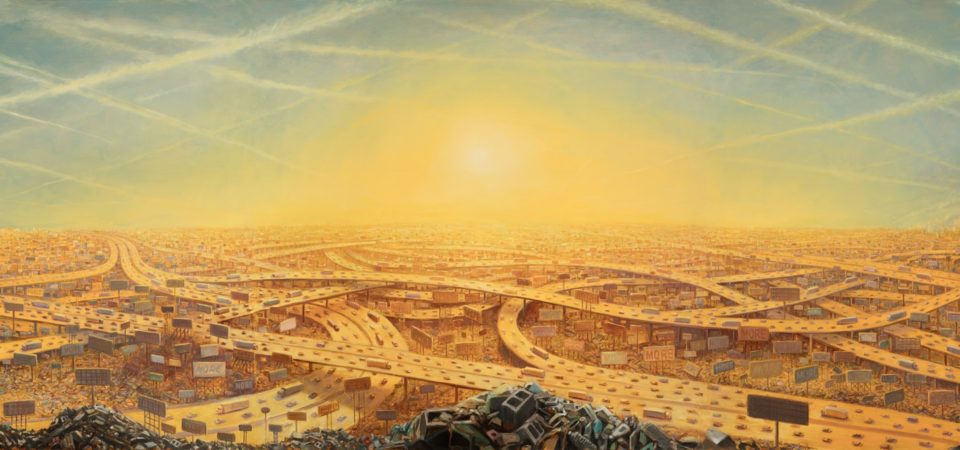A fundamental role for an artist is to create work that captures the current zeitgeist so others may better understand what is happening in the world. By being attuned to their surroundings, an artist can visually transmute their insights via their art, to show where we are and where we are headed. They can effectively shine a light into the darkness, to reveal a glimpse of the future.
For the past twenty years, I have been making art about our hyper-consumptive society and the ecological impact I see it having upon the planet. I consider climate change to be the most important issue we face today, and yet frustratingly, we are not responding swiftly enough to this existential threat. My concern for the planet and our future viability is why climate change is the primary focus of my work.
Many scientists and writers are voicing concerns about climate change, but I believe artists can contribute something as well. Art has the capacity to communicate ideas in a fundamental way that is beyond the scope of verbal language or statistical data. Art can inspire, educate, and empower others. My goal is to reach as many people as possible with my work, with the aim of raising awareness about our perilous path. My hope is to compel people to consider the consequences of our collective actions.
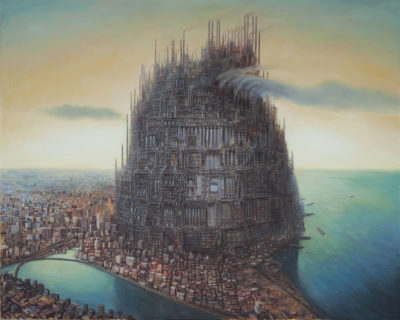
Recently I have been painting allegories about the dynamics that underlie our society, and the potential consequences of our present actions. I seek to question the rationale of our choices and attempt to reveal the dichotomy that may exist between what we desire and what we manifest. I frequently use specific imagery to convey these ideas. For example, I depict cars and traffic-laden freeways as they symbolize for me our fossil fuel-based infrastructure. I portray sprawling cityscapes and massive piles of discarded consumer goods, to illustrate our proclivity for limitless growth and excess. And I render billboards and signs with the word “MORE” as this embodies the mantra of capitalism, which I consider to be the underlying force driving our insatiable appetite to consume everything possible.
Certain themes frequently appear in my work. One that I commonly explore is the idea of hubris or our collective folly in pursuing unsustainable goals. My painting “Their Refinement of the Decline”, for example, uses a massive, refinery-looking structure to illustrate this concept. In my narrative, the inhabitants of a vast metropolis have constructed a giant machine that is meant to clean up the pollution and environmental mess they have produced. Unfortunately, when they switch on this enormous device, it belches smoke and leaks oil, causing as much harm as good. I consider this a metaphor for our proclivity for quick fixes when confronting the problems we have created. Our solutions often fail to correct the situation, and sometimes result in potentially worse circumstances. It is like kicking the proverbial can down the road. When faced with difficulty, we often choose the fastest panacea rather than address the underlying problem with a well-reasoned resolution.
The composition for “Their Refinement of the Decline” derives from a well-known work by 16th-century Flemish painter Pieter Bruegel called “The Tower of Babel”. I often like to use images from art history for inspiration. Not only is this my way of paying homage to some of my favorite artists, but it unites my work with the ever-growing canon of painting through time.
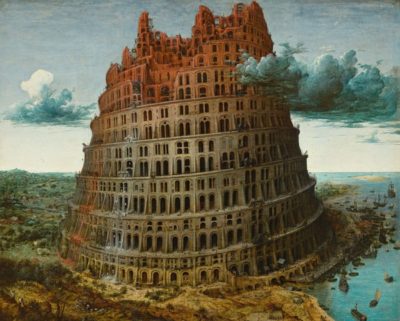
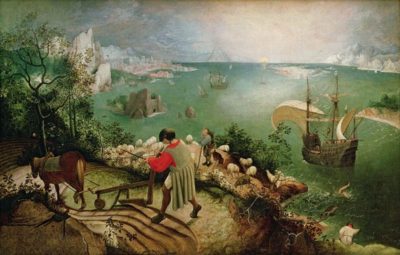
Another work by Bruegel that I have used for inspiration is his painting “The Fall of Icarus”. It is about the Greek myth of Icarus, which tells of a young man who attempted to escape imprisonment on the isle of Crete, by using wings made by his father from feathers and wax. Icarus ignored his father’s warning to not fly too close to the sun, and the sun’s heat melted Icarus’ wings, causing him to plunge to his death into the sea. And like Bruegel’s painting “The Tower of Babel”, this work is about hubris or failed ambition. It shows an expansive landscape of ordinary, daily life in the 16th century. In the foreground, a farmer plows his field, while further in the distance, a shepherd watches over his flock, and ships venture to far off cities. Scarcely visible, however, in the lower right corner of the painting, is Icarus plummeting into the ocean. His tragic death seems to go unwitnessed by everyone in the painting.
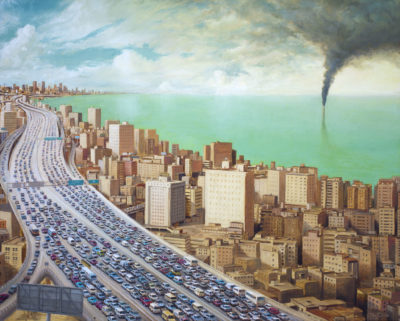
I see the same thing happening today. We currently go about our daily lives, inadvertently doing things which contribute to problems like climate change, and yet few of us seem to be heeding the warning to change our ways. My painting “A Means to an End” emulates Breughel’s composition by depicting a sprawling city beside the ocean. In the foreground, a dense artery of automobile traffic stretches off to the horizon. The commuters obediently follow one another, immersed in their routine. Meanwhile off in the distance, a smokestack protrudes cryptically from the oddly tinted water. And like Icarus falling to his death, no one pays attention to the black smoke spewing into the air. Out of sight, out of mind.
I chose the title “A Means to an End” for its dual interpretations. One could refer to the everyday pursuits of the inhabitants of this vast city, and the freeways which allow people to move about, from one place to another. A more ominous interpretation, however, could be that it refers to the unseen forces that power this society and their dire consequences.
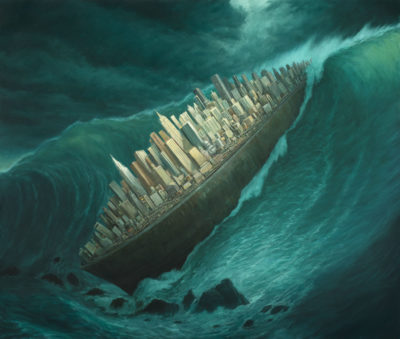
Another image about impending peril is my painting “Blindside”. In Plato’s Republic, there is a parable about a ship of fools, which uses the dysfunctional crew of a ship to illustrate the many problems that arise when systems of governance lack proper knowledge. I consider the fools who inhabit my city-ship to be people who either ignore or deny the existence of climate change. These passengers are so entrenched in their flawed mindset, they fail to heed the warnings of imminent danger. My painting shows the moment when the reality of their fatal mistake finally hits home. Due to ignorance and inaction, these fools do not see the threat barreling down on them until it is too late.
I hope I am wrong about my visions of the future. I want to believe we will find a way to avoid the many bleak challenges I see ahead for us. But with each passing year, I grow more alarmed. We are responding far too slowly to this looming ecological crisis. We continue to consume resources at an unsustainable rate. And we continue to trash the planet with little concern about the consequences. I recognize that many impediments stand in our way. To some degree, we are all culpable for creating this crisis. We seem unwilling to stop our addiction to fossil fuels. The economic system of capitalism is far too powerful, and the people who profit the most from the current status quo have no incentive to change. So, until we manage to shift to a more sustainable paradigm, I do not have a lot of optimism for our future.
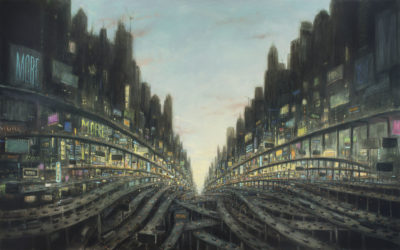
“We are surrounded by a cult of commerce. The pretty lights beckon us forward, but there is no end in sight. The signs promise to fulfill our every desire, but their words are hollow. There will never be enough. We shall never feel satiated by this mirage.” — from a Search for Meaning by Michael Kerbow, 2019.
Michael Kerbow is a San Francisco-based artist who works in a variety of media including painting, drawing, assemblage, and digitally manipulated photography. He was born in North Carolina and received an MFA from Pratt Institute in New York, before moving to the Bay Area in 1993. Kerbow’s work has been exhibited nationally and internationally and has appeared in multiple publications. He has twice been nominated for SFMOMA’s prestigious SECA award. His work is currently in a traveling museum exhibition called “Environmental Impact II”, which is an environmental-themed show touring a number of museums across the country.
This blog is part of MAHB’s ENVIRONMENTAL IMPACT II series, a travelling museum’s exhibition.
The MAHB Blog is a venture of the Millennium Alliance for Humanity and the Biosphere. Questions should be directed to joan@mahbonline.org
The views and opinions expressed through the MAHB Website are those of the contributing authors and do not necessarily reflect an official position of the MAHB. The MAHB aims to share a range of perspectives and welcomes the discussions that they prompt.

